http://twitter.com/wynkenhimself/statuses/99434066914459648
As those of you who follow me on twitter might recall, I’ve been reading David Foster Wallace’s Infinite Jest for some time now (since the beginning of last August, to be precise).
http://twitter.com/wynkenhimself/statuses/102045479528972289
For all of my nervousness that I might not finish it, ((I got a bunch of responses to that tweet from people who said they never made it through the book, which confirmed my sense that this was a real danger.)) I’ve made good steady progress and—much more importantly—I’ve really enjoyed the book. I love DFW’s writing and the characters and the loopy plot. I find that I think about them all when I’m not reading the book; they live in the back of my head and I carry them around with me as I go about my life. That’s the most I could ever ask for in a book. And few books come close to delivering that. ((Okay, some do: Jane Eyre does for me, and, unexpectedly, The Passage, which I didn’t particularly like as I was reading it, even as I couldn’t put it down, but which continues to stay with me in its vision of vampirism and the apocalypse and the power of blood. Because really, when you think about it, blood is amazing amazing stuff. No wonder we mythologize it. Also, for staying power, The Phantom Tollbooth, and not only for its brilliant Subtraction Stew, but the synaesthesia of tasty letters; Paradise Lost, which is the whole reason I ended up in early modern studies; and moments of the Torah. Abraham’s sacrifice of Isaac? I will never stop wrestling with that.))
http://twitter.com/wynkenhimself/statuses/109722096124436480
I’ve also been loving the process of reading Infinite Jest and the ways in which it has made me reshape my reading habits. In part this is about the way DFW writes and the way the book is constructed. But it’s also about reading it on my iPad and the ways in which that technology shapes reading practices.
http://twitter.com/wynkenhimself/statuses/122385512383266816
Not long after I first tweeted that I was reading Infinite Jest for the first time, my friend Amanda pointed me to Infinite Summer, the group project (with accompanying website) to read the entirety of IJ over the summer of 2009. I poked around the website a bit and came across “How to Read Infinite Jest”. Some of the advice was spot-on:
Read the endnotes: Please. They are not boring bibliographic details, but rather an integral part of the text. And the bouncing back-and-forth is a feature, not a bug.
But other pieces of advice just made me anxious:
Use bookmarks: Yes “bookmarks”, plural: one for the main text and one for the endnotes. Doing so will save you hours of searching, and the aggravation of losing your place several times an hour. Keep notes: As if lugging around a book the size of a 2 br. 1¼ bath apartment isn’t enough, you may want to carry a notebook as well. You won’t always have the requisite Oxford English Dictionary within arm’s reach, you know.
I wanted to read a novel, I didn’t want to study for an exam. I know that different people read for pleasure in different ways. But the idea of using a slew of bookmarks, of keeping notes, of relying on a reader’s guide to get me through the book sounded like I would spend more time worrying about keeping track of everything than enjoying what I was reading. By this point, I’d already read through the first chunk of the novel and had given myself over to not knowing what was going on. The opening section is amazing and compelling but also baffling. There’s a character who seems to be on some sort of school interview and seems to be some sort of sports star and is surrounded by characters whose exact relationship to him aren’t clear and who are fearful of leaving him alone with the recruiters. It’s beautifully written and I just gave myself over to it, even as I wasn’t sure what was going on. And the beginning of the novel is one vignette like that after another. There are amazing characters and incredible scenarios, but there’s not a clear sense of plot or of connection between the vignettes. I let myself roll through it and enjoy it without worrying about whether or not I was following every nuance of plot.
http://twitter.com/wynkenhimself/statuses/124923895361966080
So that was the mood I started off in as a reader. I gave myself over to Infinite Jest and put myself in David Foster Wallace’s hands. That is not the way I’m always able to read. In fact, I haven’t been able to read that way in a long time. The last time I wrote about reading ebooks, ((I notice that I was spelling ebooks with a hyphen and now I’m not.)) I mentioned that I was reading a lot of thrillers because they weren’t too demanding of me. That I had shied away from books that asked for a commitment since my father died. The change in my reading habits was one of the biggest ways his death marked me. I’d been a voracious reader from the time I was little. In my adult years, a lot of my appetite focused on nineteenth-century novels, rather than contemporary ones. Those are some big novels you can sink your teeth into, and I sank into them. ((I lived in London for a couple of years when I was finishing grad school and the Victorianness of that city (or at least my geography of that city, which took me on circuits from Highgate to the Strand and Russell Court) made those works the ideal choice, along with the fact that I had a 45-minute commute twice a day and no television license and so plenty of time to read, as well as the lovely fact that I could buy cheap editions of a nearly endless supply of those books.)) It’s been discombobulating not to be that sort of reader these last five years.
http://twitter.com/wynkenhimself/statuses/137604115315425281
Infinite Jest asked that I give myself to it and I did. If I hadn’t been able to, I don’t think I would have been able to continue with it. I read the book this way because I can and because this is how I respond to DFW’s writing. But I read the book this way, too, because this is how the iPad asks me to read it. One of the great things about reading big, huge books on it is that you’re not necessarily aware that they are big, huge books. This is what I said about The Passage and this is what I say about Infinite Jest. It’d be awfully hard to hold a 1000-page novel for any length of time, even harder when you’re the sort of reader, as I am, who likes to read at night, in bed, with the lights off and her glasses off. I’ll prop my slight iPad on my chest, but a heavy book? I’d rather not.
http://twitter.com/wynkenhimself/statuses/165458978569060353
Another great thing about the iPad Kindle app is that it turns endnotes into hyperlinks. And being able to navigate the notes, as we all know, is key. Here’s what I mean. This is a screenshot of a page in Infinite Jest. ((I say “page” but of course this isn’t a page, it’s a screen. Whatever.)) It happens to be the location I’ve bookmarked because this is as far as I’ve gotten right this very moment: ((Ok, the astute of you will notice that the screenshot was taken at 10:09 am and it’s clearly not 10:09 am when you’re reading this, and I just said that I read in bed at night which, all things considered, is probably not at 10:09 am. It’s true. I took this screenshot the morning after I’d bookmarked it, and that’s actually a couple of days before I finished this post, so who knows where I am in the book right now at this very moment.)), ((Also, if you’re really clever, you’ll think to yourself, “Didn’t she say that she reads with her glasses off? And didn’t she say in that other post that she enlarges the font to some ginormous size?” And then you’ll know that this doesn’t look exactly like what it looks like when I’m reading, because when I’m reading the font is indeed much much larger and I like to have the text be grey on a black background because otherwise it’s just too bright in a darkened room. But that’s an awfully hard screenshot to read on a blog post, so I rejiggered the whole thing for your benefit.)), ((You’re welcome.))
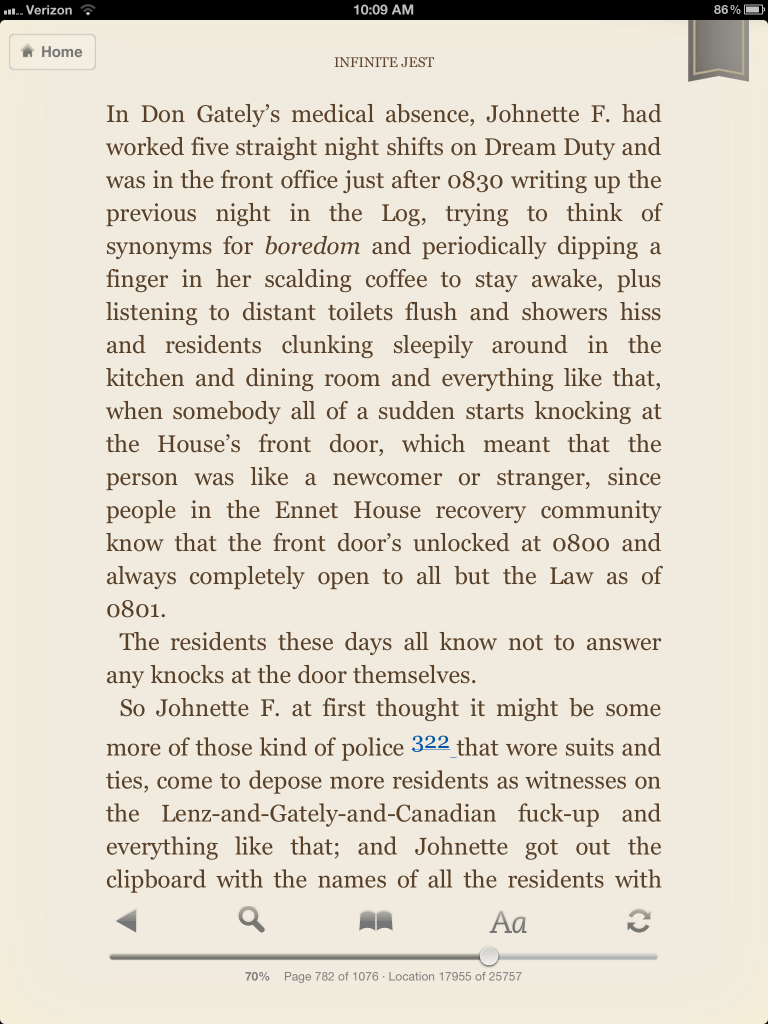
See that blue “322” in the lower quarter of the screen? That’s note 322. Click on it, and you’re taken to this screen:
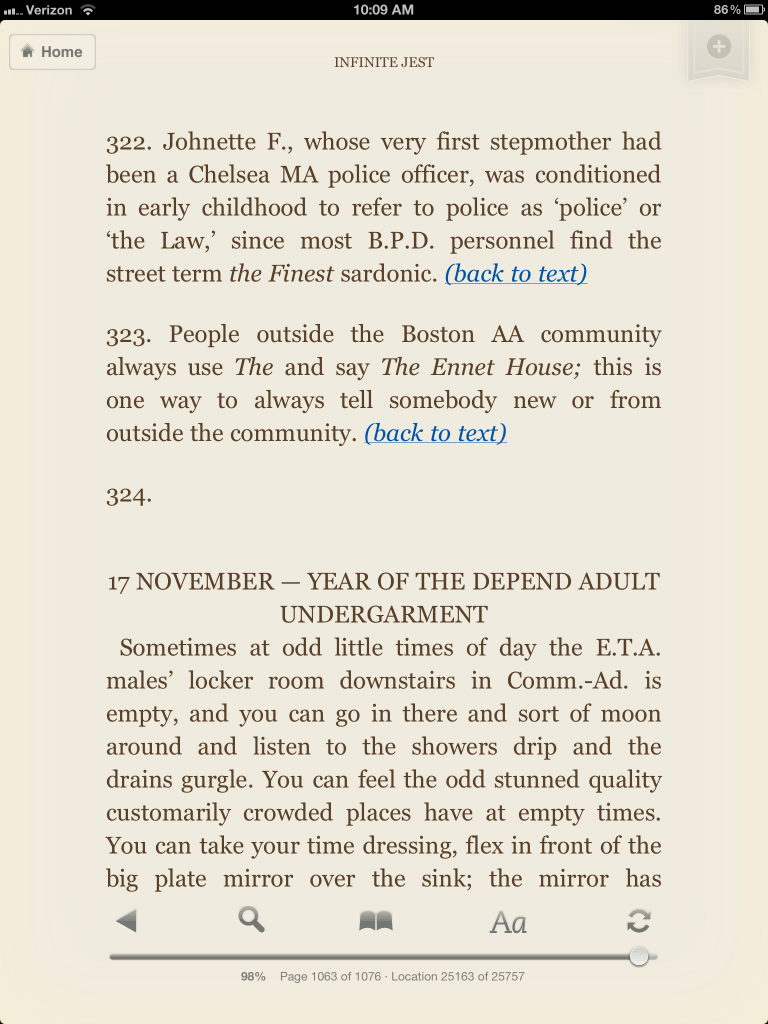
There you go! The text of note 322, easy-peasy. Click on “back to text” and you’ll go back to exactly where you were:
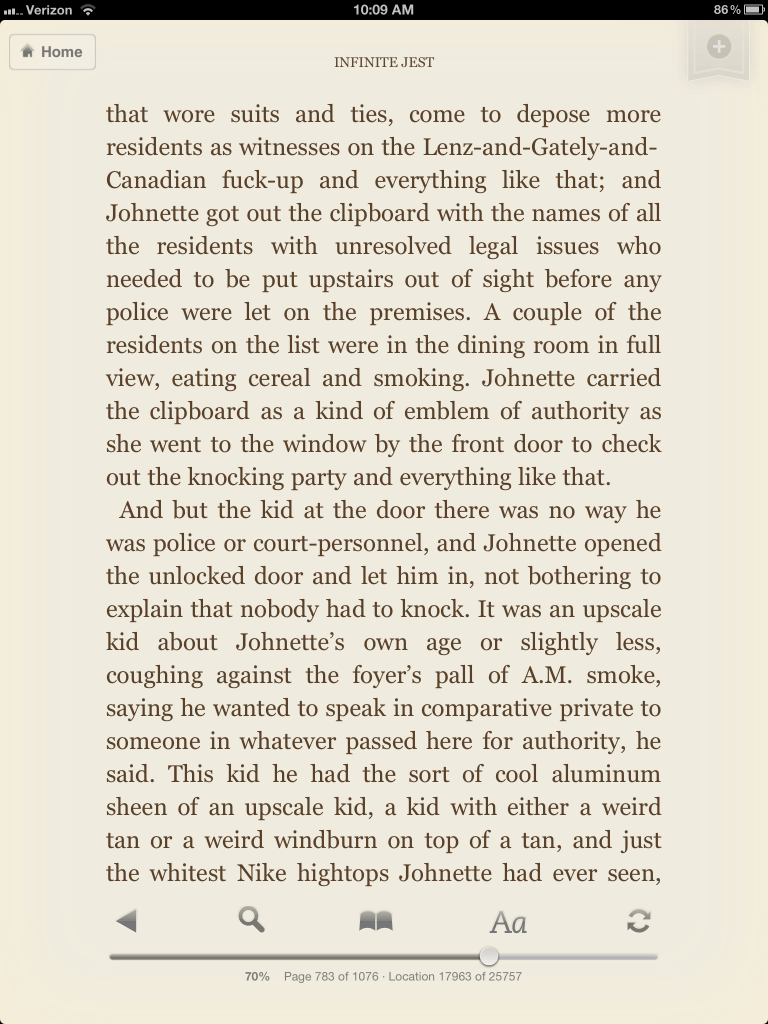
And then you can pick up reading the main text just as if nothing had happened, except that you’re actually in a different location because there are no pages here, just codes. The app’s preference for bringing me back to the next word right after the note means that I trained myself to read a few lines beyond the linked note so that I wouldn’t be so lost when I got back to a screen that started in the middle of a sentence. In any case, these hyperlinks make the book easy to read. No need for multiple bookmarks—the book takes you right where you need to go! But it also means that you really do need to give yourself over to the book and to follow its lead, because when you’re in the middle of a note, there’s no clues to bring you back to where you were. Here’s another screenshot of another passage in the book with a hyperlinked note in the middle of it:
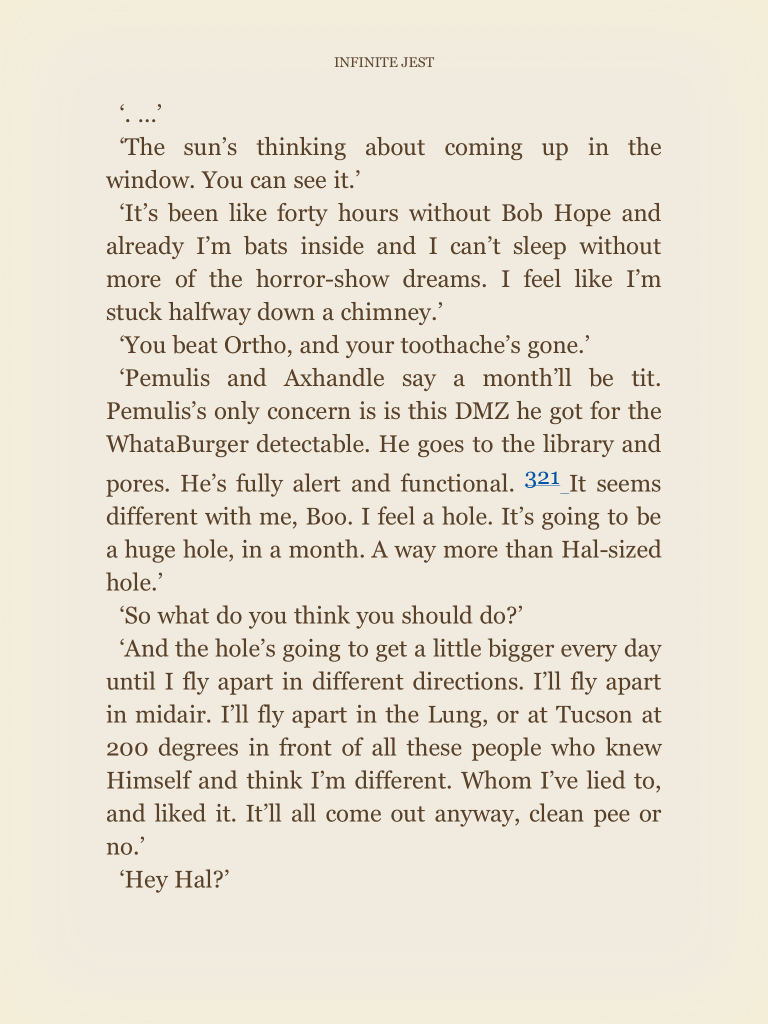
This screenshot shows more what the experience of reading the book is like: there’s no black bar at the top, there’s no location slider at the bottom. It’s just a screen of text. (To get the location indicator to show up, you need to tap in the middle of the screen; tap, it brings up the location for a moment, and then it fades away again.) Tap on the note and you’re brought to the note screen:
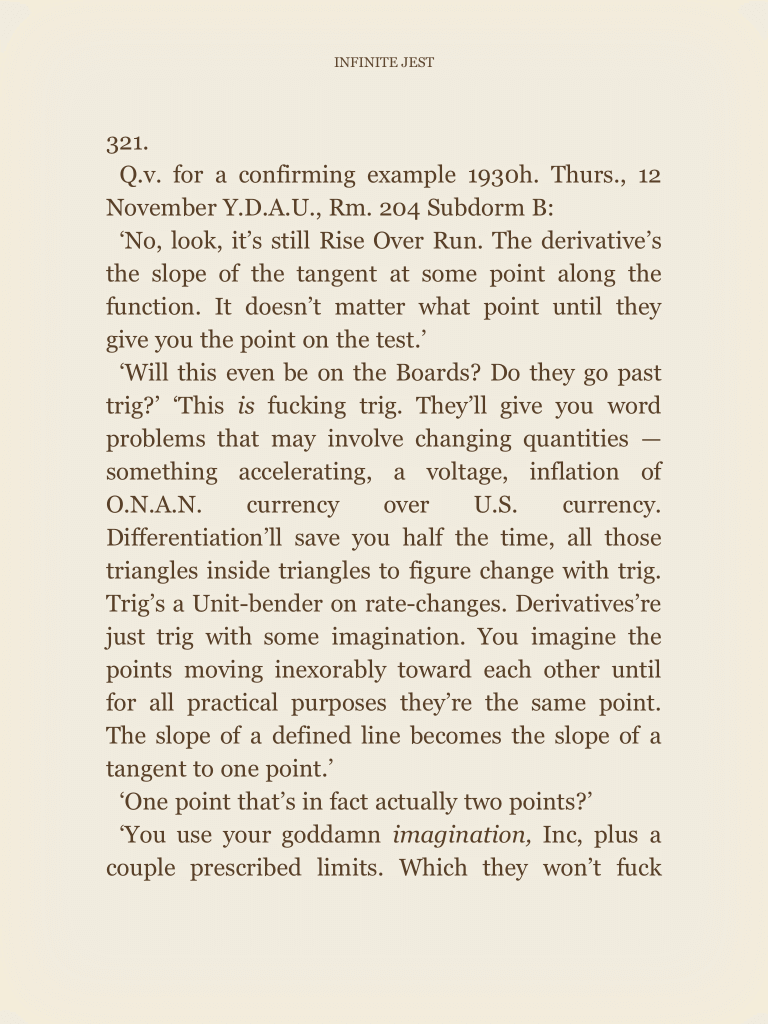
There you are, with the note marked “321.” right at the top. So far, so clear. And what happens when you continue reading note 321? After a few screens, you find yourself here:
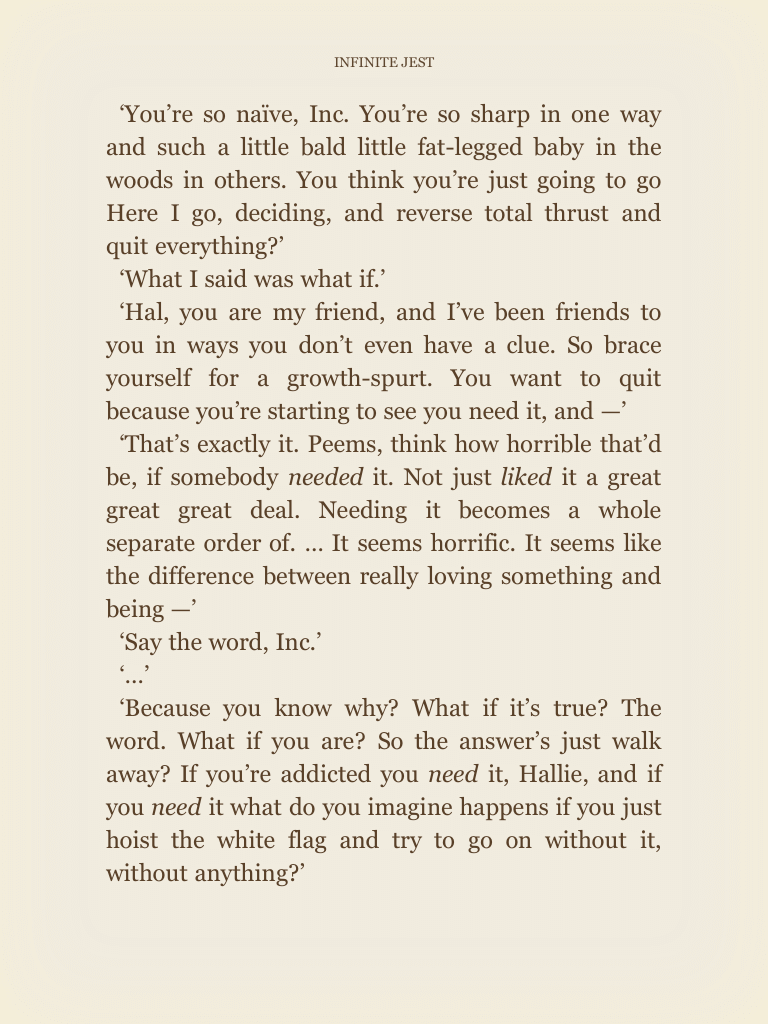
But imagine that the note continues and continues and continues, as some of them are wont to do. Where are you? Are you reading text or note? How do you know?
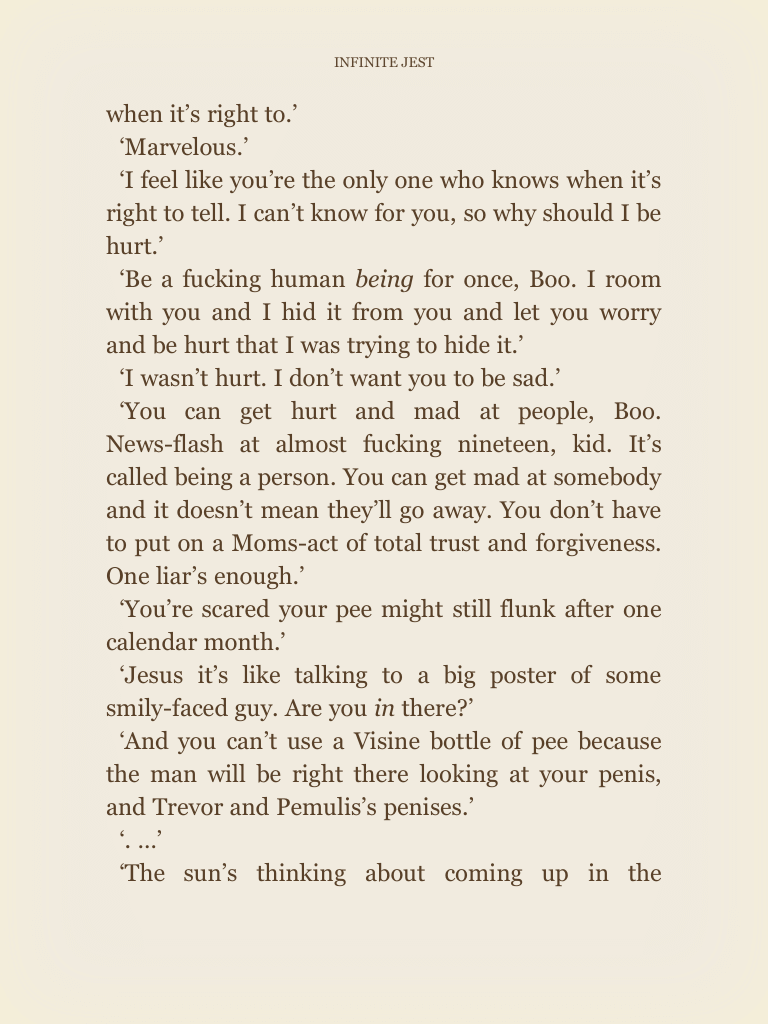
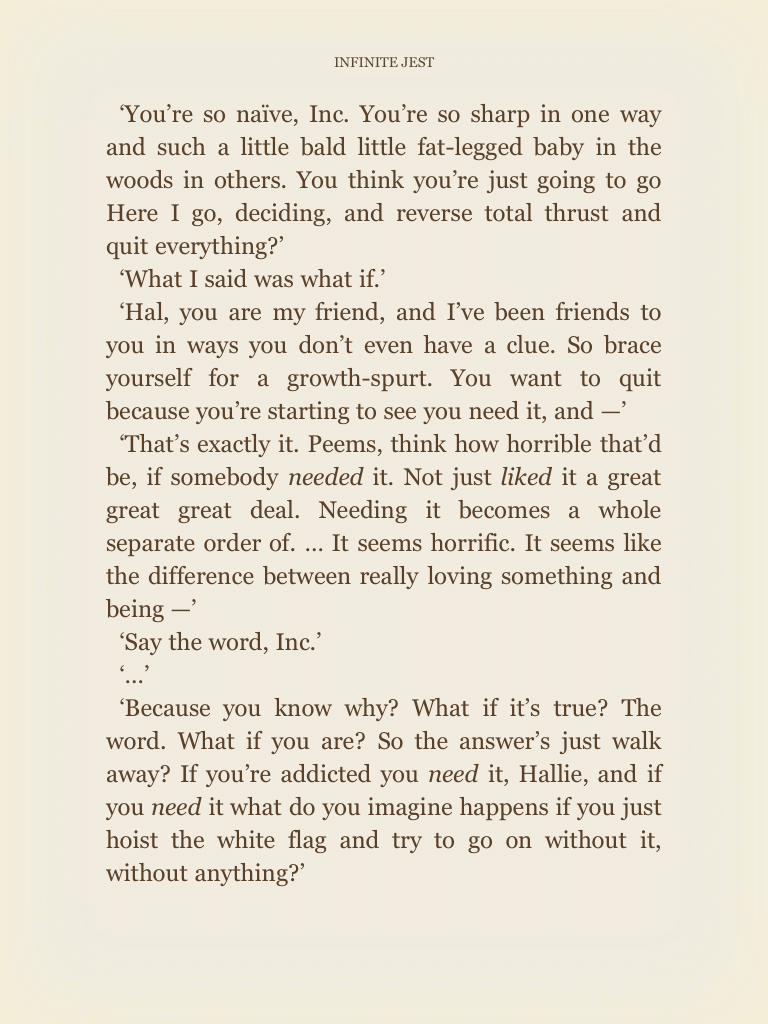
They look exactly the same, don’t they? So how do you know? Especially if the note’s been going on and on, and there’s dialogue, and plot, and words and words and words. At some point when I was reading a long note—I think, given the tweet I sent out, it must have been note 110—I actually became so confused by how long it was going on that I wondered if there’d been some sort of coding error and I was actually in the main text. And then when the notes to the notes started appearing ((The notes for the notes are indicated with superscript letters rather than numbers.)) I became even more disoriented and even though the location indicator showed that I was all the way in the back of the “book”, since there was no “book” for me to flip pages through, that didn’t really convince me that I wasn’t in the main text. And since I hadn’t bookmarked the page I had been reading, the page with the link to the note I was now wandering through, there wasn’t any way for me to go back to where I was. I could only go forward, reading and reading until I got to the safety of “return to text.” After that point, every time I saw a numbered note, I wondered if it was going to be a short one or if it was going to take me down some rabbit hole. But I made a conscious decision not to care. I refused to bookmark the page I was currently reading. I gave in to the book, went where it led me, and trusted I would make my way back to where I was and that DFW would give me the help and pleasure I needed to keep going. I ceded all my authority to Infinite Jest.
http://twitter.com/wynkenhimself/statuses/180675887543496704
I’m normally a pretty bossy reader. Resistant, even. ((Thank you, Judith Fetterley, from the bottom of my heart.)) Even a book that I love I talk back to. It’s part of how I understand what it means to read. It’s how I make sense of what I do. It’s the interpretive community I belong to. ((I suppose I should say thank you to Stanley Fish, too, even though he’s been such a pain in the ahem in many ways in recent years.)) So for me to give myself over to Infinite Jest, to put myself in David Foster Wallace’s hands, that’s a shift. I don’t know that I’ll read other books that way. I suspect I wouldn’t want this to become my new default in reading. But I am loving the experience of it. And I don’t think I would have had the same experience if I weren’t reading it on my iPad.
Here’s where I am in IJ right now. It’s where I left off reading last night, so it really does look exactly as it does when I’m reading it. I’m in the middle of a note. I don’t know which one, I don’t know how close I am to the end. But I’m really, really close. I’m not sure I’m going to know when I’m at the end except for when it stops, given that I can’t see the location bar as I’m reading and even if I did, I don’t know the starting location of the notes and so don’t know how close I am to the end of the main text. I do know that I’m going to finish this book and that I’m going to miss it when it’s done. I might go back to the beginning again to see how different it is now that I know who everyone is and what is happening. I might not. I don’t think it matters. What matters is that this book taught be to read in a new way and I’m grateful for that.
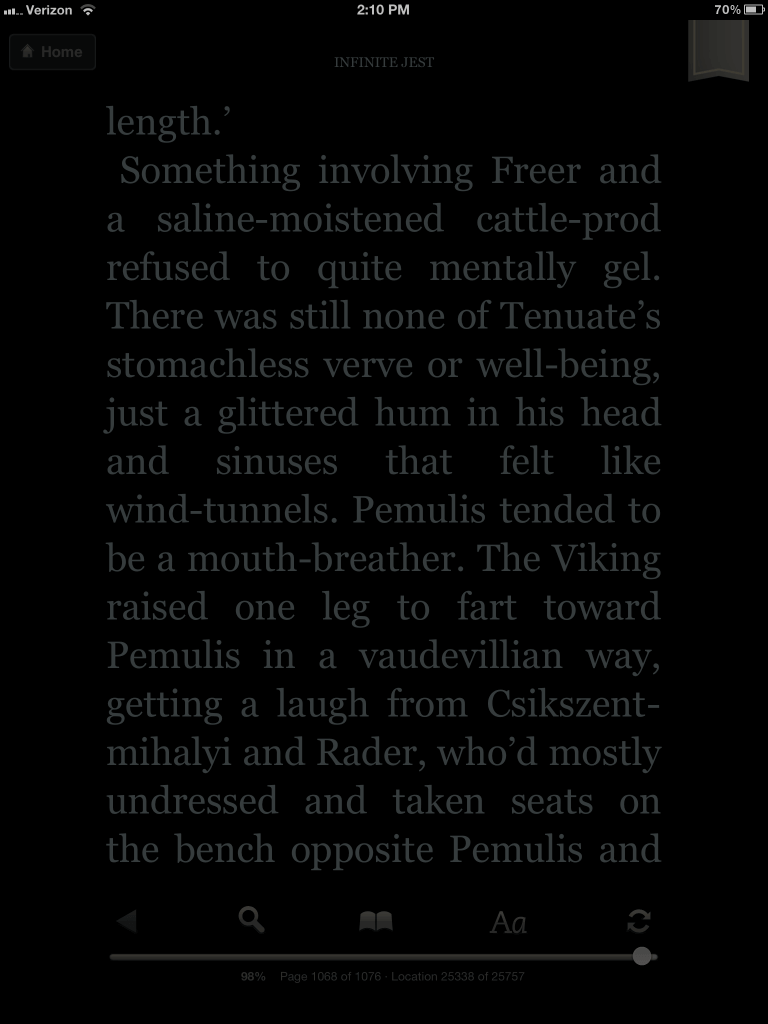
By the way, if you feel compelled to read with a guide to make sense of the many people and relationships and places in the book, Maria Popova’s Brain Pickings post from December 2010 lists three great ways to visualize the novel. I’m going to spend some time with those after I finish reading the whole thing.
And whatever you do, don’t read it the way Christopher John Farley tries to in his posts for the Wall Street Journal’s Speakeasy. He doesn’t seem to have made it more than a couple hundred pages in. I’d say it’s because he’s making it much too much work.
I do think there’s some great stuff in Infinite Summer, and though some of it rubbed me the wrong way, I’m going to spend some time with that, too, once I’m done. I did read my friend Kathleen’s fabulous post on teaching IJ and her very moving remembrance of David Wallace, who was her colleague at Pomona College.
So I guess my infinite reading will continue, whether I immediately reread the book or not.
Great post! I love the footnotes here too.
I suppose what you miss out on is the smallness of the font size in the print IF. It somehow makes it feel as though you’re reading something incidental, or secret, or whispered, or just remembered.
Thanks, Karl! I really wanted to get notes in the notes, but couldn’t spend the time to pull that off. But I love your comment on the feeling of the small font in the print book. The couple of times I picked up the book I was struck by the denseness of it. But the sense of secrecy or just-rememberedness seems so right for the book. And for the way that the people who love it share a world together that no one else quite gets.
After you finish the book the first time, make sure and go back and read opening chapter.
Really great post. I have been considering re-reading Infinite Jest since I read The Pale King last summer. I think it would be really interesting to read it on my iPad and see how the experience is different than when I read the physical copy.
Again, great post.
@Literature_Geek @briancroxall I read it on my iPad Kindle app. Worked well both for weight & notes (albeit http://t.co/2I1ZtmUKh0)
Because I was chatting with a friend about reading Infinite Jest, one of my favorite blog posts is one I wrote on it: http://t.co/2I1ZtmUKh0